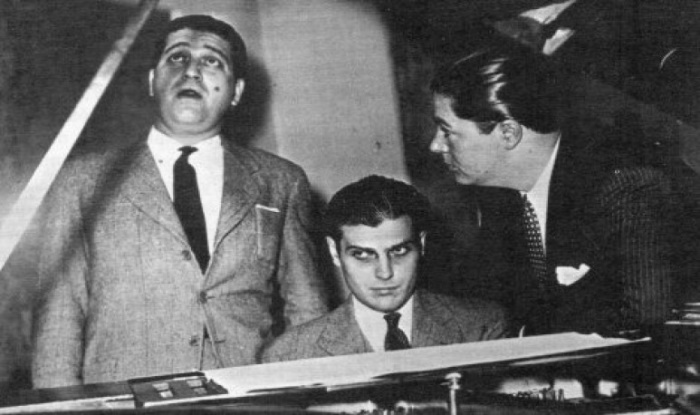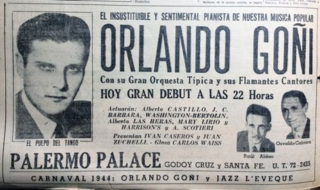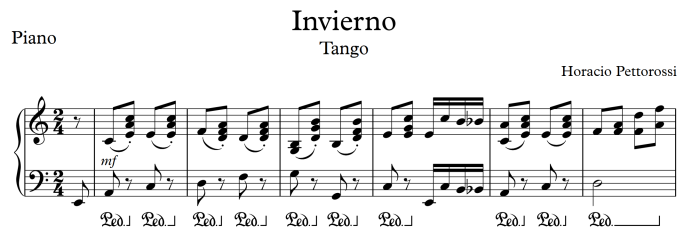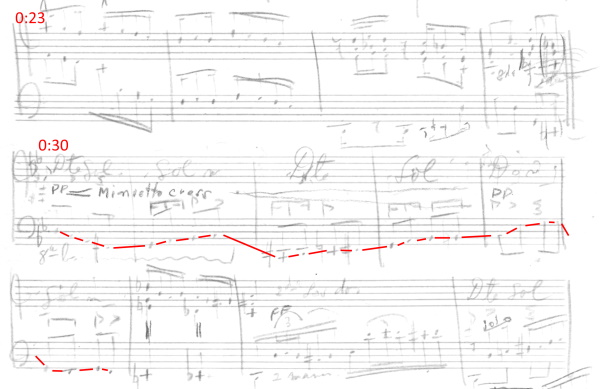
It don't mean a thing if it ain't got that swing was the credo of Duke Ellington’s orchestra, and that’s what we also could say about Orlando Goñi, one of the greatest tango pianists of all time whose influence on tango music has not been properly understood. Like Rodolfo Biagi on D’Arienzo and Osmar Maderna on Caló, Goñi made a permanent impact on Aníbal Troilo’s music. His swinging and groovy piano texture creates a resilient basis for bandoneons and violins giving them impetus to Troilo’s rhythmic extravaganza.
Let’s listen first how Goñi plays with Troilo in 1942. I would say that the recording where Goñi’s pianism shines at its best is the one of C.T.V. (aka Se te ve) recorded on January 8, 1942. The tango was composed by Agustín Bardi in the early 1930s.
Anibal Troilo - 1942 - C. T. V.
Here Goñi plays mainly three kinds on texture:
- the melody in octaves with violins and bandoneons, e.g. beginning to 0:03 and 0:07 to 0:10,
- marcato accompaniment, e.g. 0:10 to 0:21 and 0:33 to 0:36, and
- something very specific of Goñi in passages 0:03 to 0:07, 0:21 to 0:29, 0:47 to 0:51, 1:20 to 1:27, 1:46 to 1:51, and 2:01 to 2:04.
The third type of texture is called marcación bordoneada.
EDIT: You can view my transcript of C.T.V. on my YouTube channel. It contains the entire piano part as played by Goñi.
Tango C.T.V. for sexteto típico as played by Orlando Goñi and Aníbal Troilo
Man and His Career
Orlando Goñi (Orlando Cayetano Gogni, 1914-1-20 – 1945-2-5) was born in Buenos Aires, but little is known about his family background. He studied the piano with Vincenzo Scaramuzza, the maestro that also taught Osvaldo Pugliese, Lucio Demare, and Martha Argerich. His formal studies didn’t last very long because, at the age of 13, he preferred playing tango in Alfredo Calabró’s orchestra. Soon after, he formed a sexted with Alfredo Gobbi, his childhood friend with whom he shared a bohemian attitude towards life. The sextet probably didn’t make much of a success, and Goñi’s career went on in orchestras led by Miguel Caló, Manuel Buzón, Anselmo Aieta, and Juan Carlos Cobián.
Goñi got acquainted with Aníbal Troilo when they both played with Buzón and later with Cobián. They shared a view of the future of tango, and when Troilo formed his own orchestra in 1937, Goñi was the obvious choice for pianist. Some sources even say that it was Goñi who urged Troilo to put up an orchestra. Whatever the case, their cooperation lasted for more than six years, and during this time they recorded 71 tangos, valses, and milongas.
Goñi’s contribution to the orchestra was essential. Before 1942 there are just a few cases where the arranger of a recorded performance is known (namely Héctor María Artola), which suggests that most of the arrangements were created as a teamwork between the musicians, mainly Troilo and Goñi. Also C.T.V. from 1942 lacks information about the arranger, and I’m quite sure that Goñi was the key figure there.
Marcación bordoneada cannot be heard in the first two recordings Troilo and his band made in 1938. Goñi plays typical marcato en cuatro accompaniment in staccato, but some left-hand legato passages in Comme il faut suggest that something is already cooking. After this, Troilo didn’t have a chance to record until March 1941, and by then Goñi’s new style was fully developed. Listen to the passages at 0:32 to 0:34, 0:46 to 0:48, 1:44 to 1:46, and 2:13 to 2:15 in Yo soy el tango by Domingo Federico and Homero Expósito!
YouTube: Anibal Troilo - 1941 - Fiorentino - Yo soy el Tango
Goñi was known for his unorthodox playing position at the piano. He sat with his legs akimbo, which made it impossible for him to use the pedals. The sustain pedal (on the right) was used in tango (as well as in early jazz) to tie the bass note and the chord together within a bar, especially in marcato en dos, but Goñi didn’t play that way. His invention was to have separate articulations for both hands, which would have been spoiled by the use of the pedal.
Goñi stayed with Troilo till September 1943 when he wanted to start an orchestra of his own. Orquesta Típica Orlando Goñi debuted on December 1, 1943, at Café El Nacional and had massive success with thousands of listeners during the first two weeks. Goñi got a contract about appearances at Radio Belgrano in 1944, and live performances continued at larger venues.

However, a recording contract was something that Goñi wasn’t able to get in 1943 or 1944. Only four acetate records of poor quality were cut, and they alone are the audible heritage of Goñi’s own orchestra. Goñi’s interpretation of Chiqué (aka El elegante), by Ricardo Luis Brignolo from 1920, does not sound very different from Troilo. Macación bordoneada is also there.
CHIQUE - GOÑI
The tragedy of Goñi was that his bohemian character could not bear the responsibilities of a bandleader. Uncontrolled use of drugs and alcohol destroyed his health, and he died a sick man on February 5, 1945, at the house of his musician friend in Montevideo, Uruguay.
Marcación Bordoneada, What Does It Mean?
Before we dive any deeper into Goñi’s unique piano technique, let’s check the two basic musical terms.
Marcación and Marcato
Tango musicians use the word marcación when they speak about how strong beats are “marked” in musical texture, mainly in piano, bandoneon, and bass accompaniment. This involves emphasizing certain parts of the measure with marcato. The two main types of marcación are marcato en dos (aka dos por cuatro) and marcato en cuatro.
In marcato en dos, the first and third beats in a measure are emphasized, and bass notes are normally placed on these beats only. Both hands typically articulate in portato, and pedal is often used to tie the bass note and the following chord together. This makes a relaxed walking beat that was predominant in tango before 1935.

Invierno - Francisco Canaro
In marcato en cuatro, the four beats in a measure are equally emphasized, and staccato articulation is typically used. This creates an agitated mood and was the primary fuel in the beat revolution initiated by Juan D’Arienzo in 1935. During the following few years, all rhythmically oriented tango orchestras also adopted this marcación.

ALBERTO CASTILLO CON RICARDO TANTURI RECUERDO MALEVO
However, marcato en dos also prevailed and has been used interchangeably with cuatro to characterize different sections in a tango arrangement.
Other modelos de marcación include pesante, yumba, sincopa, and bordoneo, but we don’t go any deeper into them except the last one.
Bordoneo
The general Italian music term bordone (Engl. drone) refers to a situation where a low note or a chord is sounded continuously throughout a passage or a whole piece. One can get the idea of the drone by thinking of the sound of a bagpipe or a hurdy-gurdy, both of which have a set of fixed drone reeds or strings. In Argentine music, however, bordoneo refers to a guitar texture that consists of long bass notes (plucked with the thumb) and broken chords in shorter note values above that. A typical bordoneo pattern looks like this:

Because the bass moves and is not stuck to one note, this is not a real drone, though.
Although this example was written in 2/4 time (one could also use 4/8 or 4/4 with double note values), the bordoneo pattern is not a simple divisive rhythm. If you look at the values of the bass notes, you might notice that bordoneo follows an additive metric pattern of 3+3+2. The broken chords on upper strings also follow this pattern.

The 3+3+2 pattern is called tresillo. Closely related to habanera, it is one of the cornerstones of Latin American music and part of its African roots. I plan to write an article on the rhythmic foundations of tango in the near future, so I won’t go into any more details now.
Bordoneo is the most important accompaniment pattern of milonga campera, the traditional countryside milonga sung by payadores. The following video contains more than half an hour of milonga campera with bordoneo.
TODO PAYADORES "VOL 2".
C.T.V. in Close View
Now that we know the background, we can look at Goñi’s playing in more detail. I transcribed a marcación bordoneada passage in C.T.V. – the one that first comes at 0:21 and again at 1:20. It was quite exciting to know that nobody has ever done this before. I had to use some digital tricks (filtering, pitch shifts by octave etc.) to make all notes audible enough, but I’m pretty reliant that this is what Goñi actually played:

After having the notes in place, I added my suggestion for fingerings in order to show that it is humanly possible to play the passage. If you play the piano, try it yourself! It does not require any virtuoso skills because even I can play it. All notes are conveniently withing the compass of the hand, and only in the last two measures the right hand moves a bit.
The slur above the left-hand stave indicates that Goñi is playing legato, just like the guitar in bordoneo. His left hand moves mainly in the lowest whole octave of the piano keyboard, partly lower than the double bass. At the same time his right hand plays broken chords, not unlike those in bordoneo, and in typical guitar range. So there is similarity all right, but where’s the 3+3+2? It’s there, believe me, but first we should check what Goñi’s little fingers are doing.

These syncopated notes Goñi plays in both hands outline the whole texture. They stand out as melodic accents without being accented by force – partly because of their position on the edge of the texture, partly because they sound longer than the other notes (except in the last two measures). Let’s call them backbeat accents. The right-hand accents are reinforced by another simultaneous note, and the ones in the left hand by the fact that they are played on the lowest and second-to-lowest keys of the piano keyboard.
Look at the right hand now, how many semi-quavers (1/16 notes) are there in each measure before the backbeat accent? The answer is three. How many semi-quavers do the accented notes last in measures 12 and 13? The answer is three, again. How many semi-quavers are there between the accent and the bar line in measures 14 and 15? The answer is five. Now here we have the 3+3+2 pattern!

Now let’s have a look at the left hand! We notice that there is no 3+3+2, but there’s something else. Why is Goñi playing those grumbling low notes with his little finger? To make a backbeat, is the simple answer, just like in the right hand. The backbeat initiates a movement in each measure, and this movement continues between the hands. For each bass note on beat, there is an off-beat note either below or above (with just two exceptions). The texture kind of swings around the bass line.

So what is this groovy piano style with “walking” legato bass and backbeats between every bass note? It’s called boogie-woogie! Let’s listen to Earl Hines playing boogie-woogie in 1940.
1940 HITS ARCHIVE: Boogie Woogie On St. Louis Blues - Earl Hines
Count Basie recorded his Boogie Woogie in 1941.
Count Basie - Basie Boogie
Boogie-woogie became popular in blues music during the 1920s, and by 1940 it was widely known and played by several jazz pianists. We might think that at least one of them made a tour to Buenos Aires between 1938 and 1941 and happened to play at a club or café where Goñi was having his rum or champaign. And if not, gramophone records by Hines, Basie, and others must have been available for enthusiasts to buy.
So Goñi combined two major African-American music cultures into a microcosm between his pinkies – the right hand picking the tresillo rhythm of the Pampa while the left swinging to the black beat of the cotton fields. The combination created a groove that was totally unique in tango. No other pianist was able to recreate it, neither before Goñi nor after him. What a genius he was!
Legacy
After Goñi quit with Troilo and then passed away, many pianists tried to imitate his style. The first and foremost was Astor Piazzolla who had been playing in Troilo’s orchestra since 1939 and started writing arrangements for the band just a few months before Goñi left. In addition to the bandoneon, Piazzolla also played the piano and had to stand in for Goñi when he was too drunk to come to a gig. In 1944 Troilo recorded a tango by Gregorio Suriffi and Alberto Barbera named Bien porteño with José Basso on the piano. Piazzolla’s arrangement was found posthumously in Troilo’s cupboard, and it contains this passage that resembles Goñi’s style.

It does contain a legato bass line in quavers – I have marked it with a red line – but there is no broken-chord bordoneo in the right hand, just accented non-broken chords in 3+3+2 rhythm. The swinging movement between the thumb and the little finger is missing in both hands. It seems that Piazzolla had paid some attention to Goñi’s playing, but he didn’t know all the details.
You can find the legato bass passage at 0:30 in this video.
YouTube: Anibal Troilo - 1944 - Bien porteño
During the coming years, Troilo played several arrangements by Piazzolla and others where the heritage left by Goñi’s is limited to legato bass and “something” above it. With his own orchestra, Piazzolla concentrated on boogie-woogie placing the right-hand chords on backbeats. El rápido is an old tango by Roberto Firpo. The recording is from 1947 with Atilio Stampone at the piano. The boogie begins at 0:33.
Astor Piazzolla - El Rápido
But it was not only Troilo and Piazzolla who used legato bass. During the late 1940s and from the 1950s it was adopted by several orchestras, even by D’Arienzo, who once had been playing the sharpest staccato in marcato en cuatro. Here pianist Fulvio Salamanca plays legato bass with his left hand while his right hand ticks ordinary marcato with some sincopas.
Juan D'arienzo - 1951 - El simpatico
We don’t know for sure if legato bass really came from Orlando Goñi or if it was just something that came into fashion when the time was right. One thing we know is that now, during the 21st century, it is with us more than ever, thanks to many bands that use it in danceable tango – check YouTube for Sexteto Milonguero, for instance. The microcosm created by Orlando Goñi is not there, but whenever we hear a legato bass played, we can try to imagine how Goñi would have played that piece.
But legato bass was not the only thing Orlando Goñi left behind. One can ask what Aníbal Troilo’s music would have been like without Goñi, and I’m quite sure it would lack many features we now connect to Troilo. Of course, Goñi’s influence was evident during Troilo’s rhythmic and bright period when Goñi was playing with him, but it also carries on during his dark years in the 1950s. Goñi was one of the dear friends Troilo mourned during the 1950s, and he paid tribute to them by recording tangos like Responso or Discepolín. Troilo’s tribute to Goñi was the tango named Orlando Goñi by Alfredo Gobbi, a close friend of Goñi, which Troilo recorded twice in 1952 and 1965.
Anibal Troilo - 1952 - Orlando Goñi
While writing this, I found that there is much more to investigate regarding Goñi and his influence on Troilo’s style. For instance, comparing the two versions of Malena against the manuscript found in Troilo’s cupboard seems very compelling. And perhaps I’ll transcribe the whole piano part of C.T.V. when I have more time – we’ll see!